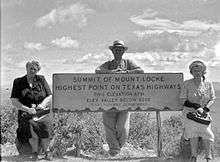Davis Mountains
| Davis Mountains Limpia Mountains | |
|---|---|
|
Davis Mountains | |
| Highest point | |
| Peak | Baldy Peak atop Mount Livermore |
| Elevation | 8,378 ft (2,554 m) |
| Coordinates | 30°38′N 104°10′W / 30.633°N 104.167°WCoordinates: 30°38′N 104°10′W / 30.633°N 104.167°W |
| Geography | |
| Country | United States |
| State | Texas |
| Geology | |
| Age of rock | Paleogene |
| Type of rock | Igneous |
The Davis Mountains, originally known as Limpia Mountains, are a range of mountains in West Texas, located near Fort Davis, after which they are named. They are a popular site for camping and hiking and the region includes Fort Davis National Historic Site and Davis Mountains State Park. The historical and architectural value of the fort, along with the rugged natural beauty of the park are a significant destination for tourism in Texas.

Origin, geology and vegetation
The mountains are of volcanic origin composed of strata associated with eruptions of the Trans-Pecos Texas volcanic field 35 million years ago.[1] The highest peak in the Davis Mountains is Mount Livermore at 8,382 feet, and is the fourth highest peak in Texas.
Vegetation in the mountain range is similar to some other sky island ranges in west Texas, New Mexico, Arizona, and northern Mexico, and includes montane grasslands, pine-oak woodlands and isolated stands of ponderosa pine forest at higher elevations.[2]
Conservation
Since 1996, The Nature Conservancy has acquired 33,000 acres (130 km²) in the mountain range, along with conservation easements on 70,000 acres (280 km²) more. This parcel is open to the public at specified times.[2]
Facilities
McDonald Observatory is accessed by Spur 78 from State Highway 118. Spur 78 is the highest state maintained road in Texas at 6,791 feet near the summit of Mt. Locke where the older telescopes of the observatory are located. Spur 77 branches off from Spur 78 providing access to the newer research equipment atop Mt. Fowlkes.

Texas Separatist Standoff
The Texas separatist organization known as the Republic of Texas has its origins in the Davis Mountains. On April 27, 1996, the leader of the group, Rick McLaren, staged an attack on his neighbor's house and demanded that he cede his property to the Republic of Texas. This led to 300 state troopers surrounding his house with him, his five followers, his wife, and the victims of the attack inside for close to a week. Ultimately, one follower was shot in the standoff and McLaren was arrested and imprisoned for the equivalent of a life sentence. [3]
Climate
| Climate data for Mount Locke weather station, Texas. (Elevation 6,150ft) | |||||||||||||
|---|---|---|---|---|---|---|---|---|---|---|---|---|---|
| Month | Jan | Feb | Mar | Apr | May | Jun | Jul | Aug | Sep | Oct | Nov | Dec | Year |
| Record high °F (°C) | 80 (27) |
79 (26) |
88 (31) |
94 (34) |
96 (36) |
104 (40) |
100 (38) |
104 (40) |
96 (36) |
94 (34) |
82 (28) |
80 (27) |
104 (40) |
| Average high °F (°C) | 53.5 (11.9) |
56.9 (13.8) |
63.7 (17.6) |
71.4 (21.9) |
78.6 (25.9) |
84.5 (29.2) |
82.7 (28.2) |
81.3 (27.4) |
76.6 (24.8) |
70.5 (21.4) |
61.2 (16.2) |
54.4 (12.4) |
69.6 (20.9) |
| Average low °F (°C) | 32.0 (0) |
33.9 (1.1) |
38.2 (3.4) |
45.2 (7.3) |
52.4 (11.3) |
58.2 (14.6) |
58.9 (14.9) |
58.4 (14.7) |
54.4 (12.4) |
48.0 (8.9) |
38.7 (3.7) |
33.6 (0.9) |
46.0 (7.8) |
| Record low °F (°C) | −10 (−23) |
−6 (−21) |
4 (−16) |
11 (−12) |
26 (−3) |
36 (2) |
40 (4) |
40 (4) |
29 (−2) |
13 (−11) |
8 (−13) |
−2 (−19) |
−10 (−23) |
| Average precipitation inches (mm) | 0.68 (17.3) |
0.49 (12.4) |
0.40 (10.2) |
0.50 (12.7) |
1.63 (41.4) |
2.49 (63.2) |
3.83 (97.3) |
3.69 (93.7) |
2.95 (74.9) |
1.61 (40.9) |
0.61 (15.5) |
0.60 (15.2) |
19.46 (494.3) |
| Source: The Western Regional Climate Center[4] | |||||||||||||
External links
| Wikimedia Commons has media related to Davis Mountains. |
- Davis Mountains from the Handbook of Texas Online
- Davis Mountains and Indian Lodge - December 5, 2007 - Houston Chronicle
- Davis Mountains photographs, hosted by the Portal to Texas History
- Davis Mountains State Park - Texas Parks and Wildlife
- Davis Mountains Preserve - Nature Conservancy
- U.S. Geological Survey Geographic Names Information System: Davis Mountains
References
- ↑ "40Ar/39Ar chronology and volcanology of silicic volcanism in the Davis Mountains, Trans-Pecos Texas", doi:10.1130/0016-7606(1994)106<1359:AACAVO>2.3.CO;2 Geological Society of America Bulletin November 1994 v. 106 no. 11 p. 1359-1376, accessed September 13, 2010
- 1 2 "Davis Mountains Preserve". The Nature Conservancy http://www.nature.org/ourinitiatives/regions/northamerica/unitedstates/texas/placesweprotect/davis-mountains-preserve.xml. External link in
|website=(help); - ↑ Branson, Hailey. "Today in Texas History: Long live Republic of Texas! Separatist group standoff in mountains begins". Houston Chronicle.
- ↑ "Seasonal Temperature and Precipitation Information". Western Regional Climate Center. Retrieved April 1, 2013.